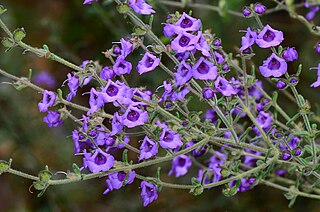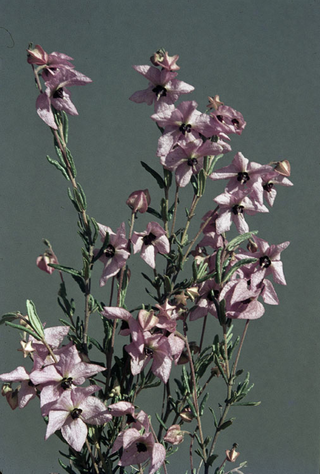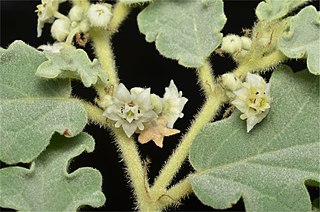
Olearia stuartii is a species of flowering plant in the family Asteraceae and is endemic arid parts of inland Australia. It is compact, spreading shrub or undershrub with lance-shaped leaves and blue to mauve and yellow, daisy-like inflorescences.

Olearia asterotricha, commonly known as rough daisy-bush, is a species of flowering plant in the family Asteraceae. A tall shrub with white, mauve or blue daisy like flowers growing from the Blue Mountains in New South Wales to western Victoria, Australia.

Prostanthera hirtula, commonly known as hairy mintbush, is a species of flowering plant in the family Lamiaceae and is endemic to the south-eastern continental Australia. It is a strongly aromatic, densely hairy, spreading shrub with narrow egg-shaped leaves and dark mauve flowers, and that grows in exposed, rocky sites.

Darwinia helichrysoides is a species of flowering plant in the myrtle family Myrtaceae and is endemic to a small area in south-west of Western Australia. It is a slender shrub with linear leaves and drooping heads of about 4 red and green flowers surrounded by many glabrous bracts.

Billardiera fusiformis, commonly known as Australian bluebell, is a species of flowering plant in the family Pittosporaceae and is endemic to the south-west of Western Australia. It is a sturdy, shrubby climber that has linear to narrowly elliptic leaves and blue, white or pink, nodding flowers arranged singly or in groups of up to four.

Billardiera coriacea is a species of flowering plant in the family Pittosporaceae and is endemic to the south-west of Western Australia. It is a woody scrambler or climber that has more or less oblong leaves, the flowers white to pale yellow and arranged singly or in small groups on short side shoots.

Billardiera drummondii is a species of flowering plant in the family Pittosporaceae and is endemic to the south-west of Western Australia. It is a slender climber that has linear leaves and tiny nodding, blue or mauve flowers arranged in groups of up to three.

Olearia magniflora, commonly known as splendid daisy-bush, is a small shrub with clusters of deep mauve to purple flowers.

Prostanthera baxteri is a species of flowering plant in the family Lamiaceae and is endemic to the south-east of Western Australia. It is an erect shrub with narrow egg-shaped to linear leaves and white flowers with a tinge of blue to pale mauve.

Prostanthera chlorantha, commonly known as green mintbush, is a species of flowering plant in the family Lamiaceae and is endemic to the south-east of South Australia. It is a small shrub with small, broadly egg-shaped to round leaves and mauve, bluish green, or greenish red to greenish yellow flowers with a pink tinge.

Pultenaea laxiflora, commonly known as loose-flower bush-pea, is a species of flowering plant in the family Fabaceae and is endemic to south-eastern continental Australia. It is a low-lying to prostrate, spreading shrub with linear to narrow egg-shaped leaves with the narrower end towards the base, and yellow and red to brown or purple flowers.

Olearia paucidentata, the autumn scrub daisy, is a species of flowering plant in the family Asteraceae and is endemic to the south-west of Western Australia. It is a shrub with variably-shaped leaves, and white, mauve or blue and mauve or yellow, daisy-like inflorescences.

Olearia muricata, commonly known as rough-leaved daisy bush, is a species of flowering plant in the family Asteraceae and is endemic to the south-west of Western Australia. It is an erect shrub with flat, linear to triangular leaves, and white or pale mauve and yellow, daisy-like inflorescences.

Leucopogon assimilis is a species of flowering plant in the family Ericaceae and is endemic to the south of Western Australia. It is an erect, slender shrub with linear or lance-shaped leaves and pink to white, tube-shaped flowers.
Leucopogon cryptanthus, commonly known as small-flowered leucopogon, is a species of flowering plant in the heath family Ericaceae and is endemic to the south-west of Western Australia. It is slender, diffuse, much-branched shrub that typically grows to a height of about 15 cm (5.9 in). Its leaves are erect and linear, 2–6.5 mm (0.079–0.256 in) long, rigid and sharply pointed. The few flowers are small and inconspicuous, arranged singly, in short spikes or in clusters at the ends of branches in cymes with leaf-like bracts and bracteoles at the base. The sepals are less than 2 mm (0.079 in) long, the petals joined at the base, forming a tube shorter than the sepals, the petal lobes about as long as the petal tube.
Cryptandra glabriflora is a flowering plant in the family Rhamnaceae and is endemic to Kalbarri National Park in Western Australia. It is a low shrub with linear or oblong leaves and clusters of white or pink, tube-shaped flowers.

Leucopogon insularis is a species of flowering plant in the heath family Ericaceae and is endemic to the south-west of Western Australia. It is a rigid, scrubby shrub with many branches, linear or oblong leaves and tube-shaped, white flowers.

Guichenotia sarotes is a species of flowering plant in the family Malvaceae and is endemic to the southwest of Western Australia. It is a spindly, low-growing shrub with densely hairy new growth, hairy, greyish, linear leaves and pink to purple flowers arranged in loose groups of two to six.

Androcalva leichhardtii is a species of flowering plant in the family Malvaceae and is endemic to central Queensland. It is a small shrub with hairy new growth, wrinkled, egg-shaped to lance-shaped leaves with irregular serrations on the edges, and small groups of yellow flowers.

Billardiera floribunda, commonly known as white-flowered billardiera, is a species of flowering plant in the family Pittosporaceae and is endemic to the south-west of Western Australia. It is a robust twining shrub or climber that has thick, leathery, elliptic leaves and white or pinkish flowers arranged in groups of ten or more.


















